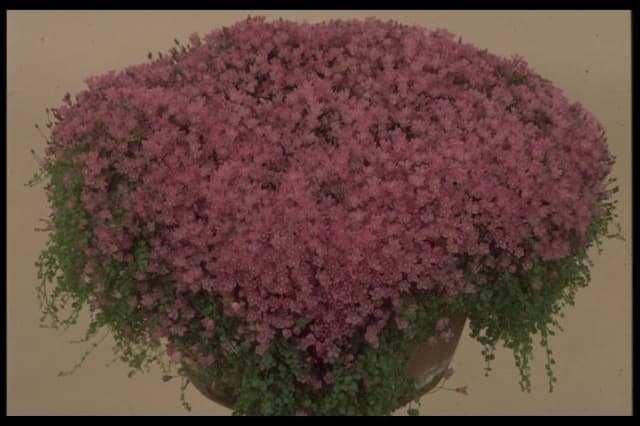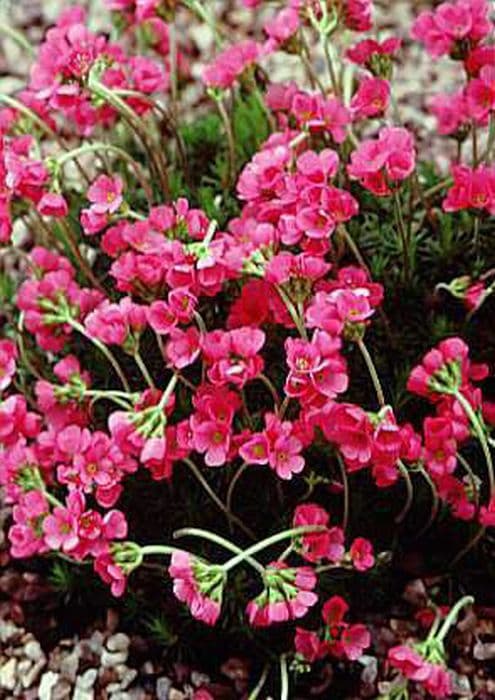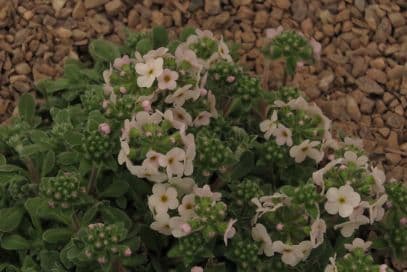Cyclamen 'Halios White' Cyclamen persicum 'Halios White' (Halios Series)

ABOUT
'Halios White' is a tuberous perennial to 30cm, with marbled foliage and pure white flowers in early winter
About this plant
 Names
NamesFamily
Primulaceae.
Synonyms
Florist's Cyclamen, Persian Cyclamen, Sowbread.
Common names
Cyclamen persicum 'Halios White' (Halios Series).
 Characteristics
CharacteristicsLife cycle
Perennials
Foliage type
Evergreen
Color of leaves
Variegated
Flower color
White
Height
6-9 inches (15-23 cm)
Spread
6-9 inches (15-23 cm)
Plant type
Bulb
Hardiness zones
9
Native area
Mediterranean
Benefits
 General Benefits
General Benefits- Aesthetic Appeal: Adds beauty and elegance to indoor and outdoor spaces with its pure white flowers and attractive foliage.
- Seasonal Interest: Blooms principally in winter and early spring, providing color and interest during a time when many other plants are dormant.
- Compact Growth: Suitable for small spaces, pots, and borders due to its contained growth habit.
- Long Blooming Period: Offers a long-lasting display as the flowers can persist for several weeks under ideal conditions.
- Gift Plant: Often given as a gift during the holiday season due to its festive appearance and winter blooming.
- Easy to Care: Requires minimal maintenance when given the correct environment and care, making it convenient for beginner gardeners.
- Versatile Use: Can be used as a houseplant, in container gardens, or in sheltered outdoor flower beds.
- Relatively Pest-Free: Less prone to pest issues, which simplifies care and maintenance.
 Medical Properties
Medical PropertiesThis plant is not used for medical purposes.
 Air-purifying Qualities
Air-purifying QualitiesThis plant is not specifically known for air purifying qualities.
 Other Uses
Other Uses- Cyclamen persicum 'Halios White' can be used as a natural insect deterrent due to its slightly toxic properties, making it a less common alternative for keeping pests at bay.
- The tubers can be processed and used as soap, in some traditional practices, because of their saponin content.
- As a symbol of love and tenderness, the plant is often used in celebrations of engagements and weddings in certain cultures.
- In art, the distinctive shape and white color of Cyclamen persicum 'Halios White' flowers often inspire botanical illustrations and garden-themed artworks.
- The floral patterns of Cyclamen are sometimes used in design and textiles, providing inspiration for fabric prints and wallpaper designs.
- With its attractive foliage and blooms, the plant is used in photography, often serving as an elegant subject for still life compositions.
- Cyclamen plants are utilized in educational settings, such as schools or botanical workshops, for teaching plant biology and horticulture.
- Incorporated into winter-themed displays and events due to its blooming season, providing a touch of natural beauty during colder months.
- Used in crafting, the dried flowers can be incorporated into potpourri mixes or pressed flower projects for decorations or gifts.
- Due to the plant's compact size, it can be an ideal addition to miniature gardens or terrariums, offering a touch of elegance and color.
Interesting Facts
 Feng Shui
Feng ShuiThe Cyclamen is not used in Feng Shui practice.
 Zodiac Sign Compitability
Zodiac Sign CompitabilityThe Cyclamen is not used in astrology practice.
 Plant Symbolism
Plant Symbolism- Love and Affection: Cyclamen are often associated with deep love and sincere affection, making them a popular gift between romantic partners or close friends.
- Parting and Goodbye: In some cultures, giving a cyclamen can symbolize a parting or saying goodbye, often with the hope of reuniting in the future.
- Maternal Love: The nurturing aspect of cyclamen symbolizes a mother's love, with its protective qualities and caring nature.
- Sincerity and Trust: Cyclamens are known to symbolize sincerity and trust, making them a poignant gift when aiming to convey genuine emotions.
 Water
WaterCyclamen require careful watering. The Persian cyclamen should be watered whenever the top inch of soil feels dry, which may be about once a week, depending on environmental conditions like humidity and temperature. Use lukewarm water and water from below by filling a tray and letting the plant soak up the water through the drainage hole for 15 to 30 minutes, then discard any excess water. Aim to provide roughly one inch of water, which may equate to around 16 ounces for a standard pot size, ensuring even soil moisture but avoiding waterlogged conditions. It is better to err on the side of underwatering than overwatering, as cyclamens are prone to rot if they sit in too much water.
 Light
LightPersian cyclamen thrives in bright, indirect light. It's best placed in a north or east-facing window where it gets plenty of light but is shielded from the intense direct rays of the afternoon sun. Avoid placing it in full shade or overly dim areas, as insufficient light can lead to poor flowering and leggy growth.
 Temperature
TemperatureCyclamen prefer cooler temperatures and will flourish in an environment where the temperature is maintained between 60 to 70 degrees Fahrenheit during the day and between 50 to 60 degrees Fahrenheit at night. They can tolerate a minimum of 40 degrees Fahrenheit but should not be subjected to temperatures above 77 degrees Fahrenheit for extended periods. Keep them away from drafts and sudden temperature changes to maintain the ideal temperature conditions.
 Pruning
PruningPruning Persian cyclamen is important for promoting new growth and prolonging the blooming period. Remove faded flowers and yellowing leaves by twisting and tugging them gently; this helps prevent disease and encourages the development of new blooms. Pruning is best done after the flowering season, typically by reducing the foliage when it starts to yellow and die back naturally. Regularly deadheading spent flowers throughout the blooming season will also keep the plant looking tidy and encourage more flowers to form.
 Cleaning
CleaningAs needed
 Soil
SoilFor Cyclamen, the best soil mix is well-draining, with a high content of organic matter such as peat or compost, and added perlite or vermiculite for aeration. Soil pH should be slightly acidic to neutral, ideally between 6.0 and 7.0.
 Repotting
RepottingCyclamen should be repotted every one to two years or when the plant has outgrown its current pot. Repotting is best done when the plant is in its dormant stage.
 Humidity & Misting
Humidity & MistingCyclamen prefers high humidity levels, ideally between 40% to 50%, which can be achieved through regular misting or placing a humidifier nearby, especially during dry indoor heating seasons.
 Suitable locations
Suitable locationsIndoor
Place in bright, indirect light; avoid hot, direct sun.
Outdoor
Keep in partial shade, shelter from intense afternoon sun.
Hardiness zone
9-11 USDA
 Life cycle
Life cycleCyclamen persicum 'Halios White', commonly known as Persian cyclamen, begins its life cycle as a seed, sown in late winter to early spring. Upon germination, a small tuber forms and develops foliage; the leaves grow from the tuber with heart-shaped, silver-patterned green leaves, and the plant enters a vegetative state. As it matures, typically after several months, it produces stems with white flowers, each with a characteristic upswept petal shape, indicating the plant's reproductive stage. After flowering, which can last for an extended period if conditions are favorable, the plant sets seed, which is then distributed to form new plants. Following the blooming period, Persian cyclamen enters a dormancy phase, during which the above-ground foliage dies back and the tuber rests, often in a dry state throughout the summer. With the onset of cooler, moister conditions in autumn, the tuber breaks dormancy, and the cycle begins anew with the emergence of fresh leaves, preparing the plant for the next flowering phase.
 Propogation
PropogationPropogation time
Spring-Early Summer
Propogation: Cyclamen persicum 'Halios White', also known as florist's cyclamen, is commonly propagated by seed as it is the most popular and practical method for this particular variety. The best time for seeding is typically late summer to early fall, as seeds require a period of cool temperatures to germinate successfully. Sow the seeds thinly onto a well-drained seed-starting mix, covering them lightly with the growing medium. Maintain a consistent moisture level but avoid overwatering which can lead to fungal diseases. Germination can take up to 30 days and sometimes longer, so patience is crucial. Once the seedlings have developed a few true leaves, they can be carefully transplanted into individual pots. It is important to keep them in cool, well-lit conditions, avoiding direct sunlight, which can scorch the delicate foliage of young plants.









